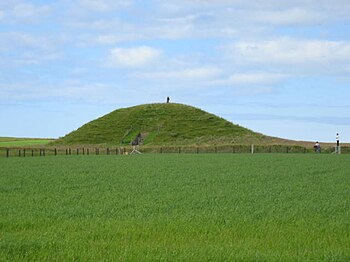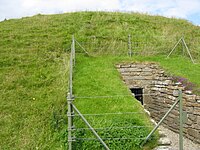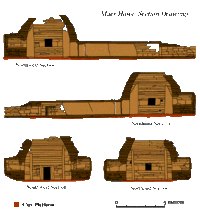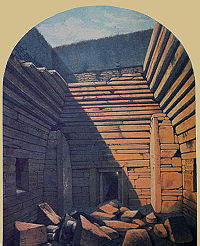Maeshowe: Difference between revisions
Created page with "right|thumb|350px|Maeshowe {{county|Orkney}} '''Maeshowe''' or '''Maes Howe'''; is a large man-made mound constructed in the Stone Age and containing a N..." |
No edit summary |
||
| Line 109: | Line 109: | ||
[[Category:Prehistoric Orkney]] | [[Category:Prehistoric Orkney]] | ||
[[Category:World Heritage Sites in the United Kingdom]] | [[Category:World Heritage Sites in the United Kingdom]] | ||
[[Category:Historic Scotland | [[Category:Historic Environment Scotland sites in Orkney]] | ||
Revision as of 12:55, 27 May 2016

Maeshowe or Maes Howe; is a large man-made mound constructed in the Stone Age and containing a Neolithic chambered cairn and passage grave. It is on Mainland, Orkney.
Archaeologists reckon that Maes Howe was built around 2800 BC. It gives its name to the 'Maeshowe type' of chambered cairn, which is limited to Orkney. Maeshowe is a significant example of Neolithic craftsmanship and is, in the words of the archaeologist Stuart Piggott, "a superlative monument that by its originality of execution is lifted out of its class into a unique position."[1] The monuments around Maeshowe, including Skara Brae, were designated a UNESCO World Heritage Site in 1999, by the name 'Heart of Neolithic Orkney'.
Name
The mound was well known the Norsemen who settled the islands three thousand years after the mound was built, and in their language it was called Orkhaugr.
The origin of the name Maeshowe is uncertain. While the second element is certainly from the Old Norse haugr usually meaning a mound, there have been several different theories postulated for the first element, maes.
These include:
- A personal name. "Maeshowe" could simply be a corruption of "Tormis' Howe", meaning it was the burial mound of someone called Tormis. Some other cairns in the area do seem to be named after individuals, and "Tormiston" is immediately adjacent to the tomb.
- Old Norse for "The Maiden's Tomb"? This would be meyjarhaugr or maerhaugr.
- Celtic origins. The Welsh word "Maes", meaning "field" or "area of activity"; it is typical for "maes" to be followed by an adjective, such as "fair field", "Maes teg". "Maeshowe" might then mean "the burial mound field", or "the area around the cairn". Due to the rarity of surviving pre-Norse elements in Orcadian placenames, this theory does not enjoy much support.
- Old Norse for "The Great Tomb"? This would be mestrhaugr. Interestingly, Maeshowe is called Orkahaugr in the Orkneyinga Saga. The first element of that name, orka, signifies power or greatness.
Siting
- Location map: 58°59’48"N, 3°11’18"W
Maeshowe appears as a grassy mound rising from a flat plain near the southeast end of the Loch of Harray. The land around Maeshowe at its construction probably looked much as it does today - treeless with grasses representative of Pollen Assemblage Zone MNH-I reflecting "mixed agricultural practices, probably with a pastoral bias – there is a substantial amount of ribwort pollen, but also that of cereals."[2]
Maeshowe is aligned with some other Neolithic sites in the vicinity, for example the entrance of "Structure 8" of the nearby Barnhouse Settlement directly faces the mound. In addition, the so-called "Barnhouse Stone" in a field around 750 yards away is perfectly aligned with the entrance to Maeshowe. This entrance corridor is so placed that it lets the direct light of the setting sun into the chamber for a few days each side of the winter solstice, illuminating the entrance to the back cell.[3]:47
The complex including Maeshowe, the Ring of Brodgar, the Standing Stones of Stenness, Skara Brae, as well as other tombs and standing stones represents a concentration of Neolithic sites that is rivalled in Britain only by the complexes associated with Stonehenge and Avebury.[4]
Design and construction

Maeshowe is one of the largest tombs in Orkney; the mound encasing the tomb is 115 feet in diameter and rises to a height of 24 feet.[5] Surrounding the mound, at a distance of 50 feet to 70 feet is a ditch up to 45 feet wide. The grass mound hides a complex of passages and chambers built of carefully crafted slabs of flagstone weighing up to 30 tons.[6] It is aligned so that the rear wall of its central chamber held up by a bracketed wall,[7] is illuminated on the winter solstice.[8] A similar display occurs in Newgrange.

This entrance passage is 36 feet long and leads to the central almost square chamber measuring about 15 feet on each side.[9] The current height of the chamber is 12½: this reflects the height to which the original stonework is preserved and capped by a modern corbelled roof. The original roof may have risen to a height of 15 feet or more.[10] The entrance passage is only about 3 feet high, requiring visitors to stoop or crawl into the central chamber. That chamber is constructed largely of flat slabs of stone, many of which traverse nearly the entire length of the walls. In each corner lie huge angled buttresses that rise to the vaulting. At a height of about 3 feet, the wall's construction changes from the use of flat to overlapping slabs creating a beehive-shaped vault.[11]
Estimates of the amount of effort required to build Maeshowe vary; a commonly suggested number is 39,000 man-hours,[12][13] although Colin Renfrew calculated that at least 100,000 hours would be required.[14] Dating of the construction of Maeshowe is difficult but dates derived from burials in similar tombs cluster around 3000 BC. Since Maeshowe is the largest and most sophisticated example of the Maeshowe "type" of tomb, archaeologists have suggested that it is the last of its class, built around 2800 BC.[15] The people who built Maeshowe were users of grooved ware,[16] a distinctive type of pottery that spread throughout the British Isles from about 3000 BC.
Style
The tomb gives its name to the Maeshowe type of chambered cairn, which is limited to Orkney.[17] Maeshowe is very similar to the famous Newgrange tomb in Ireland, suggesting a linkage between the two cultures.[18] Chambered tombs of the Maeshowe "type" are characterized by a long, low entrance passageway leading to a square or rectangular chamber from which there is access to a number of side cells. Although there are disagreements as to the attribution of tombs to tomb types, there are only seven definitely known Maeshowe type tombs.[19] On Mainland, there are, in addition to Maeshowe; the tombs of Cuween Hill, Wideford Hill, and Quanterness. The tomb of Quoyness is found on Sanday, while Vinquoy Hill is located on Eday. Finally, there is an unnamed tomb on the Holm of Papa Westray. Anna Ritchie reports that there are three more Maeshowe type tombs in Orkney but she doesn't name or locate them.[20]
Excavation

The "modern" opening of the tomb was by James Farrer, an antiquarian and the Member of Parliament for South Durham, in July 1861.[21] Farrer, like many antiquarians of the day, was not noted for his careful excavation of sites. John Hedges describes him as possessing "a rapacious appetite for excavation matched only by his crude techniques, lack of inspiration, and general inability to publish."[22] Farrer and his workmen broke through the roof of the entrance passage and found it filled with debris. He then turned his attention to the top of the mound, broke through and, over a period of a few days, emptied the main chamber of material that had filled it completely. He and his workmen discovered the famous runic inscriptions carved on the walls, proof that Norsemen had broken into the tomb at least six centuries earlier.[23]
The Norse period
The Orkneyinga Saga tells that the famous Earl Harald Maddadarson, and Ragnvald, Earl of Møre sheltered in Maes Howe during a storm.[24] in about the 12th century.
On the thirteenth day of Christmas they travelled on foot over to Firth. During a snowstorm they took shelter in Maeshowe and two of them (his men) went insane which slowed them down badly so that by the time they reached Firth it was night time.—Orkneyinga saga - Chapter 93
The Orkneymen of the Viking Age certainly entered the mound, and perhaps looted it if there was anything to loot. More than thirty Norse runic inscriptions are found on the walls of the chamber, which represent the largest single collection of such carvings in the world.
Excavations have revealed that the external wall surrounding the ditch was rebuilt in the 9th century. Some archaeologists see this as evidence that the tomb may have been reused by the Norse people and that they were the source of the "treasure" referred to in one inscription (which was either looted, or was a metaphor).[3]:46
The inscriptions have been variously interpreted. The solemn interpretations given to them may contrast with more light-heated reading, and which interpretation is to be taken may inform us how the mound was viewed by the Norse Orkneymen, and how used.
Inscriptions
The Maeshowe's runic inscriptions are occasionally obscure in meaning. The appear though to be far from the solemn or mystic texts that modern romantics like to associate with runes, as for example the phrase "Ingigerth is the most beautiful of all women" is carved beside a drawing of a slavering dog. Some appear to be showing off to companions.
As the have been translated, they include:
- "He is a viking...come here under the barrow"
- "Ingebjork the fair widow - many a woman has walked stooping in here a very showy person" - "Erlingr"
- "This is a high rune" (it is indeed – it is carved by the roof)
- "These runes were carved by the man most skilled in runes in the western ocean"
- "Ofram the son of Sigurd carved these runes"
- "Haermund Hardaxe carved these runes"
Tales of treasure were sparked by such inscriptions as:
- "It is surely true what I say that treasure was taken away. Treasure was carried off in three nights before those."
- (unless that is the reply to "Ingigerth is the most beautiful of all women"!)
World Heritage status
The "Heart of Neolithic Orkney" was inscribed as a World Heritage site in December 1999. In addition to Maeshowe, the site includes Skara Brae, the Standing Stones of Stenness, the Ring of Brodgar and other nearby sites. It is managed by Historic Scotland, whose "Statement of Significance" for the site begins:
The monuments at the heart of Neolithic Orkney and Skara Brae proclaim the triumphs of the human spirit in early ages and isolated places. They were approximately contemporary with the mastabas of the archaic period of Egypt (first and second dynasties), the brick temples of Sumeria, and the first cities of the Harappa culture in India, and a century or two earlier than the Golden Age of China. Unusually fine for their early date, and with a remarkably rich survival of evidence, these sites stand as a visible symbol of the achievements of early peoples away from the traditional centres of civilisation ... Maes Howe is a masterpiece of Neolithic engineering. It is an exceptionally early architectural accomplishment. With its almost classical strength and simplicity it is a unique survival from 5000 years ago. It is an expression of genius within a group of people whose other tombs were claustrophobic chambers in smaller mounds.[25]
See also
- Newgrange, another winter-solstice-aligned passage tomb
- Ring of Brodgar
- Skara Brae
- Standing Stones of Stenness
Outside links
| ("Wikimedia Commons" has material about Maeshowe) |
- Location map: 58°59’48"N, 3°11’18"W
- Maeshowe Chambered Cairn - Historic Scotland
- Orkneyjar
- Winter Solstice Webcam
- Research around the reappearance of the sun
References
- ↑ Pigott 1954
- ↑ Davidson & Jones 1985, pp. 27
- ↑ 3.0 3.1 Wickham-Jones, Caroline (2012). Monuments of Orkney. Historic Scotland. ISBN 978-1-84917-073-4.
- ↑ Castleden 1987, p. 93
- ↑ Childe 1952, p. 18
- ↑ Lost Worlds: "The Pagans (of Britain)" History Channel series with contributions from historian Prof. Ronald Hutton, Archeologists Erika Guttmann and Martin Carruthers
- ↑ Dargie 2007, p. 12.
- ↑ Hedges 1984, p. 160
- ↑ Childe 1952, pp.18-19
- ↑ Ritchie 1995, p. 59
- ↑ Castleden 1987, pp. 176-177
- ↑ Hedges 1984, p. 113
- ↑ Castleden 1987, p. 212
- ↑ Renfrew 1979, p. 212-214
- ↑ Ritchie 1981, p. 29
- ↑ Renfrew 1985, p. 7
- ↑ Ritchie 1981, p. 22
- ↑ Laing 1974, p. 42
- ↑ Hedges 1984, p. 80
- ↑ Ritchie 1995, p. 47
- ↑ Ritchie 1995, p. 9
- ↑ Hedges 1984, p. 22
- ↑ Ritchie 1995, p. 10
- ↑ "Maeshowe's runes - Viking graffiti" Orkneyjar. Retrieved 30 October 2008.
- ↑ "The Heart of Neolithic Orkney". Historic Scotland. Retrieved on 5 September 2007
- Castleden, Rodney (1987). The Stonehenge People. London: Routledge & Kegan Paul Ltd.. ISBN 0-7102-0968-1.
- Childe, V. Gordon; W. Douglas Simpson (1952). Illustrated History of Ancient Monuments: Vol. VI Scotland. Edinburgh: Her Majesty's Stationery Office.
- Dargie, Richard (2007). A History of Britain: The Key Events That Have Shaped Britain from Neolithic Times to the 21st Century. Arcturus Foulsham. ISBN 0-572-03342-7.
- Davidson, D.A.; Jones, D.L. (1985). The Environment of Orkney in The Prehistory of Orkney BC 4000-1000 AD (Colin Renfrew, editor). Edinburgh: Edinburgh University Press. ISBN 0-85224-456-8.
- Hedges, John W. (1984). Tomb of the Eagles: Death and Life in a Stone Age Tribe. New York: New Amsterdam. ISBN 0-941533-05-0.
- Laing, Lloyd (1974). Orkney and Shetland: An Archaeological Guide. Newton Abbott: David and Charles Ltd.. ISBN 0-7153-6305-0.
- Piggott, Stuart (1954). Neolithic Cultures of the British Isles. Cambridge University Press. ISBN 0-521-07781-8.
- Renfrew, Colin (1979). Investigations in Orkney. London: Rep. Research Comm. Soc. Antiq. London #38.
- Renfrew, Colin (editor) (1985). The Prehistory of Orkney BC 4000-1000 AD. Edinburgh: Edinburgh University Press. ISBN 0-85224-456-8.
- Ritchie, Graham & Anna (1981). Scotland: Archaeology and Early History. New York: Thames and Hudson. ISBN 0-500-27365-0.
- Ritchie, Anna (1995). Prehistoric Orkney. London: B.T. Batsford Ltd.. ISBN 0-7134-7593-5.
| Monuments of the Heart of Neolithic Orkney | ||
|---|---|---|
|
Maeshowe • Standing Stones of Stenness • Ring of Brodgar • Skara Brae | ||
|
